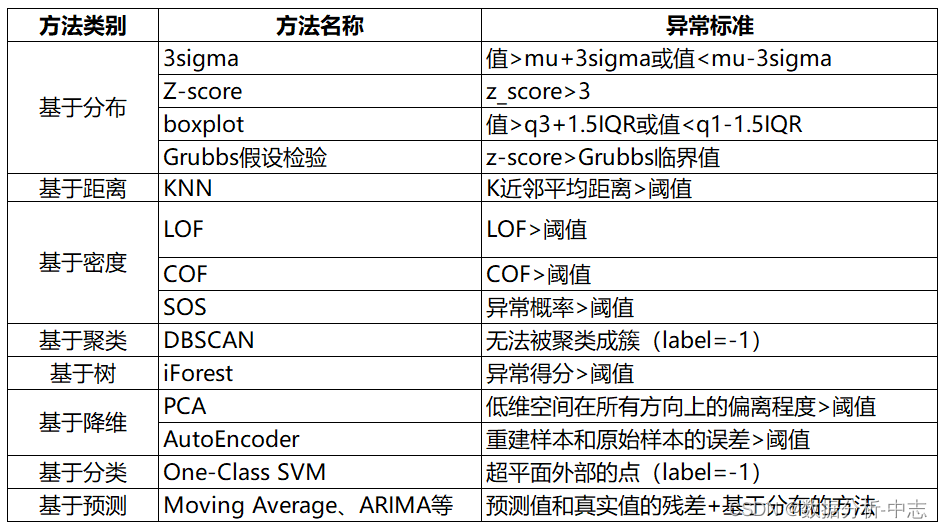数据挖掘异常检测:9个方法与实践案例
发布时间: 2024-09-08 07:55:40 阅读量: 214 订阅数: 69 


数据挖掘导论(完整版)_数据挖掘_异常检测_

# 1. 数据挖掘中的异常检测基础
在数据挖掘的广阔世界中,异常检测始终是一个充满挑战且至关重要的研究领域。它是识别数据集中不一致或罕见模式的过程,这些模式通常与常规数据的行为大相径庭,可能暗示着隐藏的复杂问题或机遇。异常检测的应用广泛,覆盖了从信用卡欺诈预防到网络安全防护的多个方面。本章将带你了解异常检测的基础知识,包括其定义、重要性以及为何数据科学家和分析师必须对它有深入的了解。随后,我们将深入探讨异常检测的理论基础和方法,为你打下坚实的知识基础,为接下来章节中的案例分析和高级技术讨论做准备。
# 2. 理论基础与异常检测方法
### 2.1 统计学方法
统计学方法是异常检测领域中的经典方法,它们通常依赖于数据的概率分布模型,并将不符合这种模型的数据点标记为异常。在这部分中,我们将深入探讨基于概率分布的异常检测和聚类异常检测技术。
#### 2.1.1 基于概率分布的异常检测
基于概率分布的异常检测假设数据遵循某种已知的统计分布,如高斯分布,然后计算数据点的概率值,并根据概率值的大小确定异常程度。一般而言,概率值较低的数据点更容易被视为异常。
```python
from scipy.stats import multivariate_normal
# 假设数据遵循多元正态分布,我们需要计算数据点的概率密度
def calculate_probability(data_point, mean, covariance):
return multivariate_normal.pdf(data_point, mean=mean, cov=covariance)
# 模拟一组数据点和一个异常点
data_points = np.random.multivariate_normal(mean=[0, 0], cov=[[1, 0], [0, 1]], size=100)
anomaly_point = np.array([-3, -3])
# 假设的均值和协方差矩阵(这里简化了计算过程)
mean = np.mean(data_points, axis=0)
covariance = np.cov(data_points, rowvar=False)
# 计算概率密度
data_point_probability = calculate_probability(anomaly_point, mean, covariance)
print(f"Probability of the anomaly point: {data_point_probability}")
```
在上述代码中,我们利用`scipy`库中的`multivariate_normal.pdf`函数来计算多元正态分布的概率密度。这种方法的关键在于正确估计数据的分布参数。在实际应用中,数据可能会偏离正态分布,因此,模型的选择和参数估计是这一方法成功与否的关键。
#### 2.1.2 聚类异常检测技术
聚类技术可以将数据分组为多个簇,簇内部数据点相似度较高,而与其它簇的数据点差异较大。异常点通常是那些不属于任何簇或者与所有簇的距离都很远的点。
```python
from sklearn.cluster import KMeans
# 使用 K-Means 算法进行聚类
kmeans = KMeans(n_clusters=3)
clusters = kmeans.fit_predict(data_points)
# 计算每个点到最近簇中心的距离,作为异常分数
distances = np.min([pairwise_distances(data_points, [kmeans.cluster_centers_[idx]]) for idx in range(3)], axis=0)
```
聚类异常检测技术的核心在于簇的数量选择和距离度量方式。选择不同的距离度量方法(如欧氏距离、曼哈顿距离)可能会影响到最终的聚类结果和异常点的判定。
### 2.2 机器学习方法
机器学习方法在异常检测中占据了重要位置,通过训练模型来学习数据的正常模式,并以此来检测偏离这一模式的异常数据点。
#### 2.2.1 基于分类的异常检测
基于分类的异常检测方法将异常检测转化为一个二分类问题,其中一个类别代表正常行为,另一个类别代表异常行为。该方法通常需要大量标注数据来训练分类器。
```python
from sklearn.ensemble import IsolationForest
# 假设我们有一个数据集和对应的标签
X_train, y_train = load_data_and_labels()
# 训练隔离森林模型作为分类器
clf = IsolationForest(n_estimators=100)
clf.fit(X_train, y_train)
# 预测新数据点的异常分数
anomalies = clf.predict(new_data_points)
```
在上述代码中,使用`IsolationForest`算法作为例子。需要注意的是,在实际应用中,标记的正常数据需要远多于异常数据,以防止模型偏向于将多数类别预测为正常。
#### 2.2.2 基于聚类的异常检测
基于聚类的异常检测是一种未监督学习方法,该方法通过聚类分析找出数据中的主要结构,然后将那些不属于任何簇的数据点视为异常。
```python
from sklearn.cluster import DBSCAN
# 应用 DBSCAN 算法进行聚类
dbscan = DBSCAN(eps=0.3, min_samples=10)
clusters = dbscan.fit_predict(data_points)
# 标记未被分配到簇的点为异常
is_anomaly = clusters == -1
```
代码中的`DBSCAN`算法是根据数据点的密度来进行聚类,参数`eps`和`min_samples`决定了簇的密度阈值。这种方法特别适用于有噪声的数据集,但需要谨慎选择参数以避免将正常点误判为异常。
### 2.3 高级分析方法
随着数据挖掘技术的不断进步,出现了更多先进的分析方法,它们能够处理更复杂和多维的数据集,其中孤立森林和基于密度的方法是两类较为流行的技术。
#### 2.3.1 孤立森林算法
孤立森林算法是一种基于树的模型,该算法通过随机选择特征和随机选择切分值来构建多棵隔离树,孤立的点会更早地被隔离出来,因此它们在树中的路径更短,这个路径长度被用来衡量异常程度。
```python
from sklearn.ensemble import IsolationForest
# 使用孤立森林算法进行异常检测
isolation_forest = IsolationForest(n_estimators=100, max_samples='auto', contamination=float(.01), max_features=1.0)
scores_pred = isolation_forest.fit_predict(data_points)
# 将孤立森林的负值视为异常点
anomalies = data_points[scores_pred == -1]
```
`IsolationForest`在数据点的异常程度预测上非常高效,尤其是在大数据集上,但如何选取`contamination`参数(异常点的比例)是一个挑战。在大多数情况下,该参数需要根据问题的上下文进行调整。
#### 2.3.2 基于密度的异常检测
基于密度的异常检测方法,例如局部异常因子(Local Outlier Factor,简称LOF)算法,根据数据点周围邻域的密度与其它区域的密度比较来判断异常程度。局部密度远小于其邻居的点被认为是异常。
```python
from sklearn.neighbors import LocalOutlierFactor
# 使用 LOF 算法进行异常检测
lof = LocalOutlierFactor(n_neighbors=20)
scores = lof.fit_predict(data_points)
# 将 LOF 的负值视为异常点
anomalies = data_points[scores == -1]
```
在使用`LocalOutlierFactor`时,参数`n_neighbors`需要根据数据集的密度进行调整。基于密度的方法能够检测出局部异常,这是其它方法所不具备的优势。
以上介绍的方法各有特点,选择合适的方法需要综合数据集的特性和业务需求。理解每种方法背后的原理及其适用场景,对于高效地解决异常检测问题至关重要。接下来,我们将进入第三章,通过实际案例来深入分析这些方法在不同领域的应用。
# 3. 异常检测实践案例分析
## 3.1 金融领域异常检测案例
### 3.1.1 信用卡欺诈检测
信用卡欺诈是金融领域中一个重大问题,利用异常检测技术可以有效地识别出潜在的欺诈行为。数据分析在信用卡欺诈检测中尤为重要,因为几乎所有的交易都可以被捕捉并进行分析。机器学习模型可以根据用户的历史交易行为进行训练,从而识别出异常模式。
例如,当一个用户突然在地理上远离其常用交易位置的地方进行了一笔大额交易时,模型便可以将其标记为可能的欺诈行为。在实践中,我们可以使用诸如随机森林、支持向量机(SVM)和集成学习方法(如梯度提升机GBM)等算法来构建信用卡欺诈检测模型。
```
```
0
0





